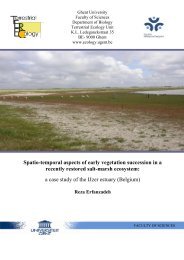PhD Arthur Decae 2010 - Ghent Ecology - Universiteit Gent
PhD Arthur Decae 2010 - Ghent Ecology - Universiteit Gent
PhD Arthur Decae 2010 - Ghent Ecology - Universiteit Gent
You also want an ePaper? Increase the reach of your titles
YUMPU automatically turns print PDFs into web optimized ePapers that Google loves.
urrow runs almost vertically into the ground and may reach a depth of 30 cm. Four to five<br />
centimeters behind the trapdoor a side tube branches off from the main burrow. This side tube<br />
reaches the soil surface a few centimeters from the trapdoor, where its surface opening is<br />
covered with a thin sheet of silk that is well camouflaged among the plant debris. On the<br />
lower side of the burrow entrance some "linear litter", as described by Main 1957, is spun into<br />
the burrow rim.<br />
Behavior: The only spider of this species kept in captivity never settled down properly. After<br />
days of hiding inactively in a shallow depression made in the clay bottom of its container, it<br />
started digging down to produce a burrow. The burrow was never completed however, and no<br />
trapdoor was built. Nevertheless, in the six months that the spider was kept in this way it<br />
captured four isopods that wandered near the open burrow. It ate these preys and removed the<br />
compacted chitin remains by working them out of the burrow entrance.<br />
Distribution (Fig. 86): Nemesia santeugenia seems to be remarkably rare. Among 120<br />
Nemesia spiders collected on Majorca, only 2 specimens appeared to be N. santeugenia.<br />
These two specimens came from 1ocations about 25 km apart in the central regions of the<br />
island.<br />
Nemesia seldeni sp. n. (Figs. 47-53, 72, 77, 81, 83)<br />
Types: Holotype ♀ (ARI4202), 4 Apri11996, Majorca, Randa, 39.503°N, 2.972°E, burrow in<br />
sloping clay-bank along forested roadside. Paratypes: Majorca: 2 ♀♀ (AR14203;<br />
9972.4015), 8 Apri11995, Randa, 39.503°N, 2.972°E, same habitat; 1♀ (AR14204), 9 April<br />
1995, Randa, 39.503°N, 2.972°E, same habitat; 1♀ (9972.4017), 4 April 1996, Llucmajor,<br />
39.500°N, 2.937°E, same habitat: 1 ♀ (9972.4016).13 October 2000, Inca-Puebla, 39.767°N,<br />
2.986°E, horizontal ground, edge of cultivated field. All leg. A. E. <strong>Decae</strong>.<br />
Etymology: The species is named after Dr P. A. Selden who rediscovered Bristowe's N.<br />
bristowei in 1989 on Majorca near Estellencs (39.655°N, 2.4800E), and provided the author<br />
with the first specimens for study.<br />
Diagnosis: Females of N. seldeni are morphologically very similar to those of N. maculatipes<br />
Doleschall, in Ausserer 1871 and N. sanzoi Fage 1917. They differ from both those species by<br />
the relatively elongated carapace, CL/CW ≥ 1.4 (n=6) in N. seldeni, CL/CW = 1.3 (n = 5) in<br />
the other two species, the lower caput (Ch/Th = 1.2 vs. 1.5-1.7), the prolateral scopula on<br />
tibiae I and II restricted to the distal half of the segment (vs. extending over the full length of<br />
the tibiae), and the prolateral spine pattern on patella III (usually 2 spines, rarely 3, in N.<br />
seldeni, vs. usually 3 spines, rarely 2, in N. maculatipes and N. sanzoi). The male is unknown.<br />
Description: Female (holotype): BL = 15.4, CL = 5.5, CW = 3.7. Leg IV: T4>F4>M4. PSP: p<br />
= 0-0; I = l-l; II = 2-2; III = 2-2; IV = 0-0. Dorsal aspect (Fig. 47). Carapace distinctly longer<br />
than wide, CL/CW = 1.5, with distinct narrow dark purplish lateral edges, and clear pattern of<br />
darker brown zones radiating from fovea over lighter, yellowish background. Brown zones<br />
cover lateral slopes of caput and follow cervical grooves and all shallow radial furrows.<br />
Clypeus narrow, Clyp = 0.17, light yellowish brown, as is cuticle at sides of eye-group and on<br />
central caput. Caput (Fig. 49) slightly elevated, Ch/Th = 1.2. Fine setae in one longitudinal<br />
row on central caput and in irregular group on clypeus and ocular tubercle. Fine hairs in<br />
irregular patches predominantly on darker colored zones and along carapace edge. Eyes (Fig.<br />
50) compactly grouped on and around steep ocular tubercle, eye-formation less than twice as<br />
wide as long, AR/El = 1.83, AR slightly shorter than PR, AR/PR = 0.98, ALE larger than<br />
PLE, ALE/PLE = 1.21, PLE pearly, other eyes greyish. POP unbroken. Fovea narrow, deep,<br />
recurved, with smal1 central longitudinal groove. Chelicerae dorsally appearing somewhat<br />
darker than carapace, distinctly bicoloured with lighter and darker brown zones, lighter zones










